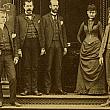
Company D, First Regiment Engineers and Mechanics
by L.H. Pammel
In 1863 Albert J. Hardy was teaching in the village of Cannonsburg, Kent County, Mich., when Father Abraham made his call for "300,000 more." The teacher and several of his young men pupils enlisted in Company D, First Michigan Engineers and Mechanics.
The regiment served at Chattanooga and in Sherman's army on the "march to the sea," and through the Carolinas to Washington, and took part in the grand review at Washington. After the battle of Lookout Mountain and Missionary Ridge, as a large number of Company D were from the "pineries" of northern Michigan, they were detailed to refit and run a large sawmill on the bank of the Tennessee river at Chattanooga. Hardy was detailed to keep the books of the mill and remained there until the fall of Atlanta.
During the siege of Chattanooga about 10,000 horses and mules died of starvation and their bodies were dumped into the Tennessee River. At one time for nearly a day the river was so full of bloated carcasses that it seemed one could cross the river by stepping from one carcass to another. The earth and wells of water were saturated with poison from the putrefying bodies. Little was known, or at least practiced, of sanitation, so many soldiers suffered from dysentery and some died.
About a month before the start on the "march to the sea," the First Michigan Engineers were sent by rail to Atlanta where they destroyed the railroad shops and public buildings. On the march to Savannah the regiment was often under fire while repairing roads and building bridges, and had much extra marching to do from one wing of the army to the other for such purpose. The regiment was also exposed about two weeks before the capture of Fort McAlister, and the surrender of the city.
Much of the time during the siege the regiment was without rations and the boys were obliged to pick up from the ground scattered grains of corn the horses and mules had left, wash, then parch them in the frying pan and eat them.
March Through Carolinas
After a month in Savannah the army started on the march through the Carolinas. The regiment endured much fatigue and many hardships, marching from one wing of the army to the other, building "corduroy" roads of pine saplings, often working in water up to the armpits, often in the night, and often without food except beans, replacing bridges, sometimes working all night under the fire of the enemy. One incident of all-night bridge building over the Edisto River is very vivid. The firing of the "reb" sharp-shooters was hot and quite constant, so much so at one time that nearly all the boys left work for safety. Hardy and one or two others would not leave without orders, when Lieutenant "Himmy" E. came running down the hill to the river and shouted, "What the hell are you fellows doing here—you'll all be shot." So the "fellows" retired in "good order." Soon a battery was planted on the bank and shelled the woods on the other side of the river, upon which the "Rebs" soon departed, and the company returned to their work on the bridges and worked all night. The bridge was ready for crossing next morning. A description of the work may be of interest.
Posts Left Standing
Only the posts of the "bents" of the former bridge were left standing in the water, extending some feet above the surface. These posts were about two feet square, their charred tops burned to points. Some of the boys made a raft, floated out to the tops and sawed them off down to the sound wood. Others cut down pine trees about fifteen inches through, cut them into logs of required length, hewed them flat on two sides for stringers, which were placed on the tops of the posts; thus two lines of stringers, running over the tops of the posts formed the foundation of the bridge. Auger holes were bored through the stringers down into the posts. Hard wood pins about two and one-half feet long, the size of the holes, were driven down through the stringers and holes into the posts, thus holding the stringers firmly in place. Small poles about six inches in diameter were pinned down to the stringers, and these formed the floor of the bridge. Wagon trains and soldiers then crossed safely over the bridge.
After passing the Edisto, the regiment marched through Columbia, S. C., when it was a mass of smoking ruins, with blackened corpses scattered about. After sixty-three days of hard marching, building roads and bridging streams, Goldsboro, N. C., was reached, and for the first time in two months the men heard from home and "God's country" and there rested and refitted for the "final lap."
March for Raleigh
After two weeks' rest Sherman's army started after Joseph E. Johnston's army, marching for Raleigh, N. C. While the regiment was trudging on the road one morning, an officer came galloping by, his horse in a foam, the officer shouting "Lee's surrendered, Lee's surrendered." You should have heard the glad shout of the boys. The army marched two days beyond Raleigh when Johnston surrendered his army to Sherman. Sherman's army then marched back to Raleigh, where it lay two weeks and rested. While at Raleigh the sad news came of President Lincoln's assassination, and a terrible gloom settled down on the men, and hardly a word was spoken for days. Then came the march to Washington and the "grand review."
Excerpt from Reminiscences of Early La Crosse, Wisconsin: An Account of the Men and Women Who Lived in La Crosse and Vicinity by L. H. Pammel. Liesenfeld Press, 1928. (Albert J. Hardy eventually left Michigan for La Crosse, WI.)

 facebook
facebook

